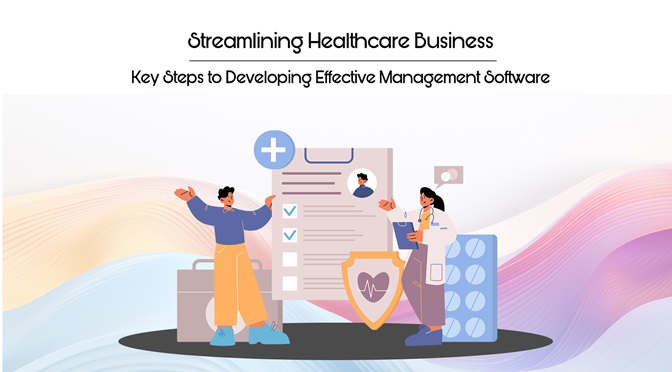Running a healthcare business is easier said than done. Where every other business has to take care of its customers, a healthcare organization has the dual responsibility of managing patients and customers. An effective management software customized by a healthcare software development company might be the answer to all your concerns.
Efficient software can help streamline operations, improve work efficiency, maintain compliance, and improve resource allocation to reduce costs and enhance patient experience. I know this because Mobmaxime has built many healthcare management software for our clients.
Here are the key steps in developing effective healthcare management software.
Purpose of a healthcare management software
Providing effective healthcare is becoming more complex over time. The increasing number of health conditions and their management difficulties, coupled with the rising expectations of patients, are boiling healthcare institutions to a boiling point.
As a result, they experience higher employee burnout, workforce shortages, and unsatisfied patients. No software (at least not until today) can help a nurse or doctor cure a patient in less time.
But, these softwares can help them manage every patient and their condition efficiently. They can make patient outreach accessible, update users on regulatory standards, and improve resource allocation.
Everything works to deliver a smooth patient experience while making changes at the ground level that conform to core values and objectives. Well-built software provides visibility into the entire stream of operations, creating room for proactive rather than reactive operations.
Some common challenges healthcare businesses face

Healthcare businesses must continuously evolve to deliver efficient patient care and experience. Given rising patient and customer expectations, healthcare institutions need an updated system to manage all processes.
Technological advancements are meant to improve core functioning, but implementing these technologies is challenging. I’ll get to that part later, but let’s first understand the challenges the healthcare business faces.
1. Lengthy patient intake process
The length of time required to address a patient upon first arrival indicates the institution’s efficiency and productivity. Higher time means lower efficiency, often seen in paper-based processes, which are also error-prone. Moreover, the lengthier processes instil a negative impact on the patients.
Generally, traditional patient intake processes are resource-intensive, meaning you will need additional paperwork, administrative staff, and storage to manage the entire process, diverting resources from patient care.
2. Maintaining patient record accuracy and accessibility
Without a healthcare management system, the majority of the processes will be manual, which means;
- Inconsistent layouts
- Loss of information
- Poor searchability
- Security risks
- Time consumption
Any of these reasons can cause negligence in maintaining medical records. When medical record keeping has evolved into science itself, don’t you think updating how you maintain the records is important? With the additional storage required for record-keeping, imagine the time required to source every document and the delay it can cause in delivering effective care.
3. Communication issues

Sharing medical records and communicating with fellow doctors, nurses, etc., is super easy when you have a healthcare management system. However, not all systems will have an in-built communication protocol. You can ask the custom software development company to integrate an intra-department communication system.
Without an HMS, delivering the right information to the right people at the right time is a challenge that needs addressing. However, a well-built HMS can help send alerts and information to the employees on their designated devices and through their preferred method of communication.
4. Difficulty in managing resources
Unorganized workflow, data security issues, and a lack of inventory management are only some of the challenges a healthcare institution might face without an HMS. Following the traditional system, it will be difficult to keep track of everything happening within the hospital, labs, pharmacies, and every department.
Key steps in developing and implementing a healthcare management software
A healthcare business management software grants multiple advantages to the organization. Starting with convenient patient access to healthcare, employee empowerment, and streamlining operations, a well-built HMS can overhaul patient and process management in an institution.
1. Identify your specific needs
Assess your requirements within the institution to determine whether you need a simple or advanced system, what level of integration you need, and what key functionalities you need addressing.
This is required because the scope of an HMS is significantly large. The solution scale you need can vary according to the scale of medical practice and the sophistication of the existing system. Furthermore, audit your existing IT landscape to identify the processes you think should be automated.
To get the whole picture, key stakeholders and department heads should be involved in identifying their specific needs and pain points to create a list of priority features.
2. Know the development challenges
Complete this step with the help of an IT expert who can fathom the scope of services required. Some unique challenges specific to the healthcare industry are;
- HIPAA Compliance
- Data Integration
- User Adoption
- Clinical Decision Support
Knowing how to address these challenges is instrumental in developing effective healthcare management software. In addition to these, there’s the scalability issue.
In general, here’s what you need to do to address these challenges;
- Use the microservices architecture to address the scalability issue and expand the software as needed.
- During the project discovery stage, carefully assess the data to be integrated and exchanged to build a strategy boasting data mapping and transformation.
- Try to focus on user-centred design with a streamlined workflow prioritizing their needs.
- Use agile development practices, including usability testing spearheaded by QA specialists, to integrate the solutions you need to effectively handle the workflow, increased data volume, and user demand.
3. Choosing the right type of healthcare management software
An extensive discussion round shall take place to choose the right type of healthcare management software because there isn’t one type. From dedicated medical diagnosis software to telemedicine, medical imaging, appointment scheduling, EHR, medical billing, remote patient monitoring, etc., you have multiple options.
There are ready-to-use SaaS-based healthcare management systems with a wide range of features and functionalities. However, at times, these cannot deliver the solution you require, resulting in spending money on additional SaaS solutions.
A better option is to hire a custom software development company, share all your requirements, and they will build bespoke management software addressing all your requirements.
4. Choose the right tech stack for the software
Your tech stack will be pivotal in building an advanced and user-centric solution. When you hire a healthcare software development company for this purpose, they will follow a solution-specific approach to choosing the tech stack, which looks like this;
- Identify the purpose, scale, and opportunity of the healthcare management software.
- Gauge the user-friendliness of the interface and the design complexity.
- Understand the scalability of the application along with its security requirements and optimization needs.
- A good review of the integration requirements will clarify what technologies are required for the software’s smooth functioning.
5. Compliance requirements
Healthcare solutions must adhere to a wide range of compliances and regulations. Where HIPAA, GDPR, etc. are the most important and most common ones, there are federal, regional, and local compliances as well.
Create a list of all the compliances and regulations applicable to your healthcare management solution. Hire compliance experts to guide you and the development team, ensuring effective adherence to all the requirements.
6. Implementation and training
A well-planned implementation process is pivotal for a successful rollout of the management software. In my experience, doing the following will help;
- Phased Rollout: Aim for a phased implementation where a pilot group first uses the solution, ironing out the inconsistencies before a full-scale deployment.
- Data Migration: Since all the healthcare data must be on the built software, create a migration strategy to bring patient data, appointment schedules, etc., onto the new system.
- Technical Support: Always have a dedicated support desk available for the employees to help them use effectively.
- User Training: Build training programs for specific departments and roles to help them use the software to its potential. You can choose from different training methods, including instructor-led sessions, online tutorials, and guides. Promote hands-on practice with the newly built solution.
7. Implementation challenges you might face
Here are the challenges you can face while planning to implement an HMS. The obstacles you face may also change according to the level of implementation.
- A lack of uniformity and systematic approach in shaping the healthcare workflows concerning different departments can pose a big challenge.
- Another challenge is gathering and digitizing all the documents to import them onto the HMS. The severity of this challenge may differ based on your existing digital readiness.
- Completely paper-based healthcare institutions will have to put in more work digitizing their entire document base than organizations with some digitization.
- A lack of trained IT experts to maintain the HMS can prevent you from capitalizing on its full potential. Moreover, without expert assistance, you might have to run to the development team for every small error, which can increase the maintenance costs.
To Sum it Up
Given the rapid changes in customer requirements and expectations, developing effective healthcare management software is essential. In addition to this, there is the need to be efficient when running a business, and any healthcare organization needs technically advanced and customized software to manage day-to-day operations.
A well-built and executed healthcare management solution has all the tools to enhance work productivity, improve patient experience, and turn chaos into a smooth operation.



